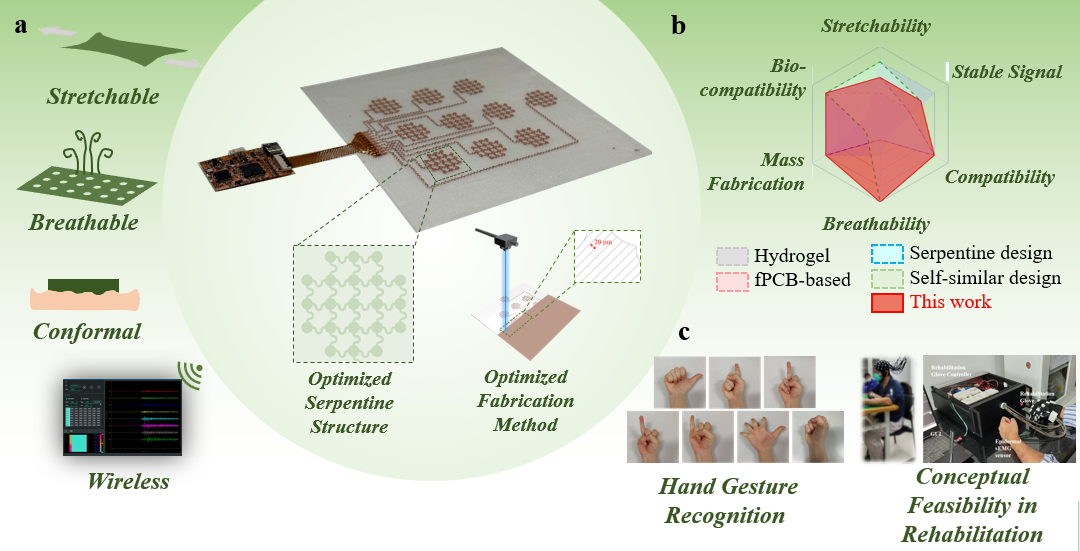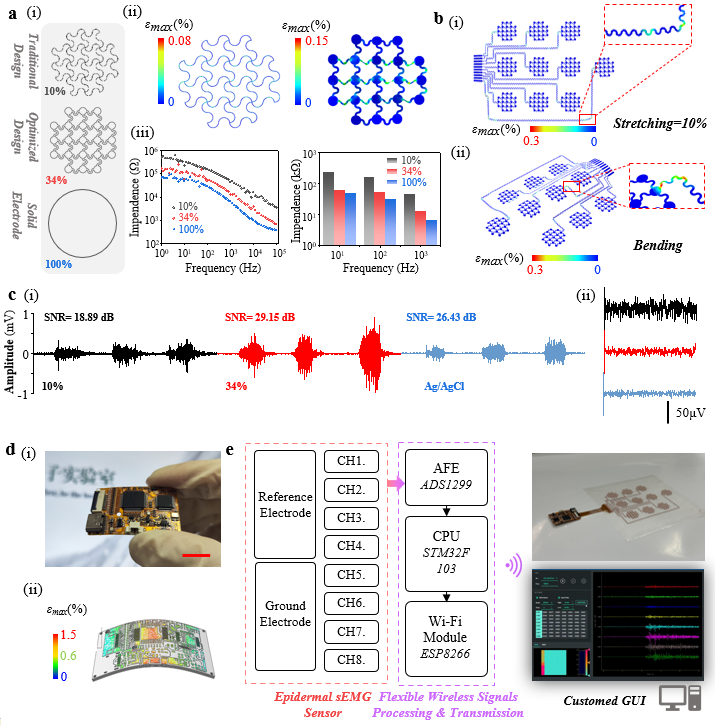Surface electromyography (sEMG) plays a significant role in everyday practice of clinic hand function rehabilitation. The materials and design of current typical clinic sEMG electrodes makes it hard to provide a stable interface between electrodes and skin for adequate long-term high-quality data.
Conformal, soft, breathable, wireless epidermal sEMG sensor systems therefore have broad potential in clinic rehabilitation settings.
The group led by YANG Hongbo from Suzhou Institute of Biomedical Engineering and Technology (SIBET) of the Chinese Academy of Sciences, and CHENG Huanyu from The Pennsylvania State University (PSU) jointly demonstrate a stretchable epidermal sEMG sensor array system recently, with optimized materials and structure strategies for hand gesture recognition and hand function rehabilitation (Fig. 1).
The optimized serpentine structures, with better stretch ability and improved fill ratio, provide lower impedance and high-quality sEMG signals. Compared to traditional serpentine design, the signal-to-noise ratio of the new sensor was increased from 18.89 dB to 29.15 dB, which greatly improved the sEMG acquisition quality (Fig. 2a-c).
The easy-to-use airhole design makes the sensor six times more breathable, further ensures its stable and long-term contact with the skin for recording, according to researchers.
In addition, integrated with a customized flexible wireless data acquisition system, the sensors achieved real-time eight-channel sEMG monitoring (Fig. 2d, e).
Binding with the CNN-based algorithm, this new sensor system also realized monitoring in seven hand gestures automatically and reliably, with an accuracy of 81.02%.
“The low-cost yet high-performance epidermal sEMG sensor system demonstrated its conceptual feasibility in quantitatively evaluation of stroke patient's hand and facilitating human-robot collaboration in hand rehabilitation by proof-of-the-concept clinical testing,” said YANG Hongbo.
The research results, entitled “Conformal, stretchable, breathable, wireless epidermal surface electromyography sensor system for hand gesture recognition and rehabilitation of stroke hand function”, were recently published in Materials & Design.
The research was supported by the National Key R&D Program of China, and the National Natural Science Foundation of China, etc.

Fig. 1. The schematic illustrating the conformal, soft, breathable, wireless epidermal sEMG sensor system and application for hand gesture recognition rehabilitation of stroke hand function. (Image by SIBET)

Fig. 2. Mechanical and electronic characterization of epidermal sEMG sensors system. (Image by SIBET)
Contact
XIAO Xintong
Suzhou Institute of Biomedical Engineering and Technology, Chinese Academy of Sciences (http://www.sibet.cas.cn/)
Phone: 86-512-69588013
E-mail: xiaoxt@sibet.ac.cn